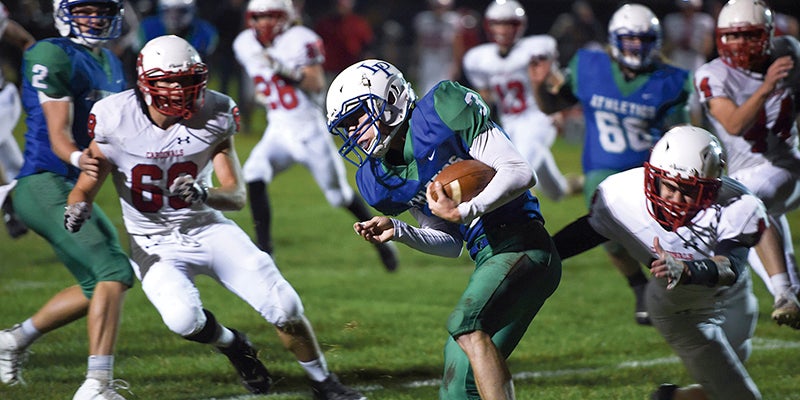Riege: Winter walleyes are sensitive to structure
Published 6:16 pm Wednesday, November 20, 2013
By Bob & Ginny Riege
The late fall or early winter is a great time to get to a river near you and catch some walleyes as they start to move up towards the head of the pools or start staging along the various breaks as they head towards the dams. River walleyes bite all year, if you know where to look and how to fish for them.
A river walleye unlike lake walleyes have to fight current all of their lives. Therefore, the walleyes in the rivers have adapted to be in areas that offer current breaks so they don’t have to fight the current all of the time. These current breaks are anything that diverts the current and allows slack water. The slack water areas are found below the dams where an eddy is formed by the water being drawn over the dam and rushing downstream causing a slack water area on each side of the dam. Other obstructions that cause slack water might be below wingdams, behind rocks, in a depression on the floor of the river, a stump or fallen tree, or man made obstacles such as bridge abutments.
It is important to understand that subtle changes in water temperature, oxygen, bottom structure, shadow lines, and similar factors make a significant difference in locating fish. Fish tend to locate along transitional zones. The bottom may change from sand to rock or from mud to weeds; a dropoff may occur or a slope into deep water; or water in one sector may be a slightly different color. The most important transition zones are the weeds. The weeds or vegetation may be the key to successful angling.
Bass seldom stay in open water and characteristically move toward some form of structure, if it is summer you can count on weeds. Muskies and northern pike are ambush feeders, lurking in or near weedbeds or an object that conceals them. Walleyes can be found on the weedline during the day feeding on small fish. Bluegill can be found in shallow water and also are found where weedbeds drop off into deeper water.
Fish are wary. This helps them survive and can also make them difficult to catch. They utilize their excellent senses of vision and hearing, detect motion with unerring accuracy using their lateral line, and also use their sense of smell. Therefore, a cautious approach is required of an angler.
The key to locating walleyes in the river in the late fall and early winter starts with locating a series of obstacles and then allowing your bait or lure to present itself in a natural manner so the walleye can race from behind the obstruction to acquire the offering and then race back into the slack water area to digest his meal and await another.
In the late fall or early winter of the year the turbidity of the water subsides and walleyes are more visually stimulated as they see food floating by the slack water areas. This is not to say that all walleyes see their food before they strike and in some cases they strike more out of vibration and smell than they do from visual identification.
With the proper head design and weight, jigs are the most versatile of all river techniques, from the shallowest flooded cover to the deepest, fastest current. The majority of river fishing with jigs involves either slipping the current or drift fishing the current breaks. The presentation is a simple lift-drop-pause method of jigging, raising the jig some 3 to 6 “ as you slip downstream. The jigs that I prefer to use are Fuzzy Grub jigs because of the rounded head. The rounded head allows the jig to bump along the bottom and not get hung up in snags or brush. If you are as vertical as possible the jig will stand up allowing the hook to be exposed away from the floor of the river. When you tip the jig with a fathead minnow the minnow stands up and looks like it is trying to pick up the jig. As the minnow struggles against the weight of the jig it sends out wounded signals and the natural scent attracts the walleyes and allows them to hang on just that much longer.
Colors of the jigs should be bright in dingy water. Colors such as fluorescent orange, chartreuse and my all time favorite, gold are great for fishing those fall walleyes. Anytime that you can bring attention to your bait it will help you up your odds for catching those fall walleyes.
Weights may range from 1/8 to 1/2 ounces, but usually stay with the weight that is the lightest but still maintains contact with the bottom. River walleyes have a tendency not to suspend as much as the walleyes in the lake and you don’t have to worry about missing a strike zone that is in the fish column. I will tip my jig with some plastic if I want to slow down the rate of fall, but current usually fights gravity faster and defeats the purpose of vertical jigging.
Slack water fish can also be found by pitching Fuzzy Grub jigs of 1/16 to 1/8 ounce to the shoreline or cover like flooded wood or boulders. The angler in this situation should use a lift drop retrieve to slip or quarter the jig downstream as it is retrieved back to the boat. This is a super tactic for fishing eddies, wing dams or shallow mid river shoals.
This winter grab some jigs, slip on a heavy coat, and head for the nearest river. Look for fish catching structure and you will find some good fall walleyes. It is my understanding that the Winnipeg river, or the Mississippi is a great place to look for some monster sensitive structured walleyes right now.




